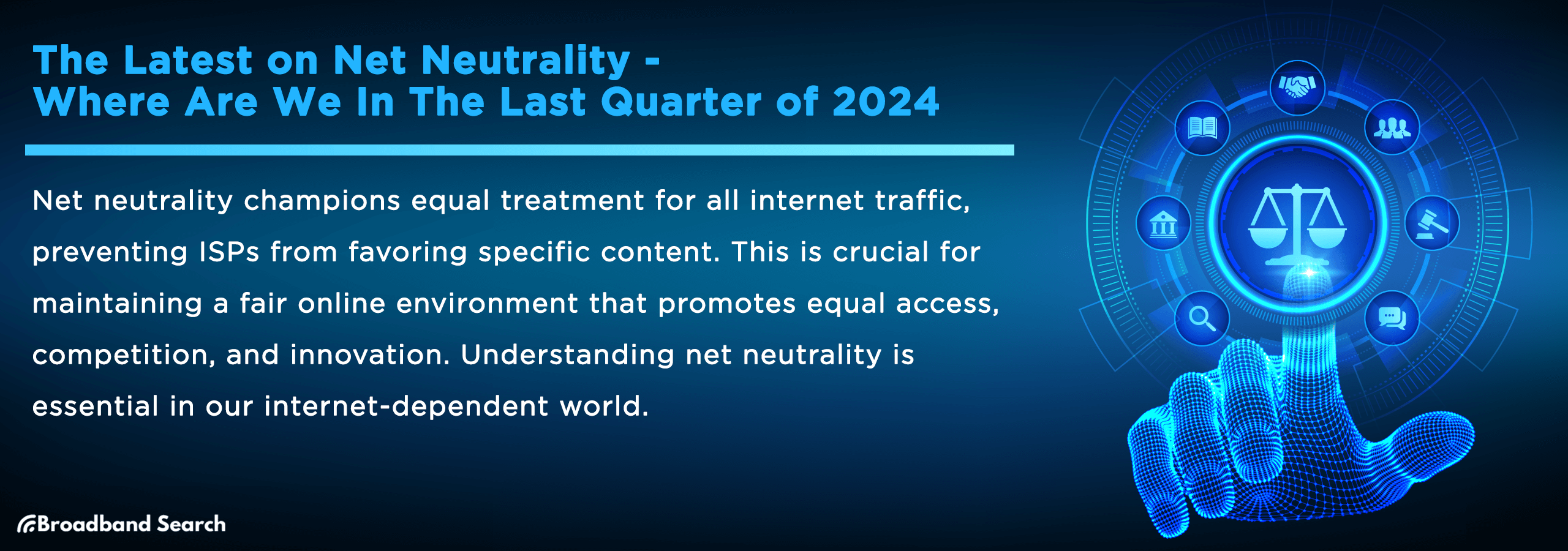Net neutrality is the idea that all internet traffic should be treated the same—no matter where it comes from, who created it, or what it's being used for. In simple terms, your internet provider shouldn’t be allowed to block, slow down, or charge extra for access to specific websites or apps.
In early 2025, a federal court ruled that the FCC does not have the authority to regulate broadband like a public utility. This decision struck down the FCC’s latest attempt to restore the 2015 net neutrality rules. As a result, the future of net neutrality now depends on Congress, not the FCC, to create lasting protections at the national level.
State-level net neutrality laws—like those in California, Washington, and Oregon—still remain in place. But at the federal level, the legal battle may finally be over, unless new legislation is passed.
What Does Net Neutrality Mean?
Net neutrality means that internet service providers (ISPs) must treat all websites, apps, and online services equally. They can’t block certain content, slow down specific sites, or charge companies to make their websites load faster.
Think of it like this: when you go online, you should be able to visit any website or use any app without interference. Whether you're streaming a movie, attending a virtual class, or browsing social media, your connection should work the same for all of them.
Without net neutrality, ISPs could create "fast lanes" for companies that pay more and "slow lanes" for everyone else. This could hurt small businesses, limit consumer choice, and make the internet less fair.
One study in 2020 showed how ISPs could create unfair advantages when there aren’t strong rules. For example, “prioritization” is when an ISP gives faster speeds to one content provider over another. There’s also “zero-rating,” where certain apps or websites don’t count against your data plan. Both of these can give big companies a leg up while leaving smaller ones behind.
Why Was Net Neutrality Repealed, and What’s Changing Now?
Net neutrality has gone back and forth for over a decade. It was first enforced at the federal level in 2015 through the Open Internet Order, then repealed in 2017. And in 2024, the FCC tried to bring those rules back—but that effort was blocked by a federal court in January 2025.
Why Was It Repealed in 2017?
Under then-FCC Chairman Ajit Pai, the FCC voted to repeal the Open Internet Order in 2017. Pai argued that heavy regulation would slow down internet innovation and investment. The repeal removed the federal rules that had previously stopped ISPs from blocking or throttling content or creating paid “fast lanes.”
The move was highly controversial, triggering nationwide protests and legal challenges. Supporters of net neutrality said the repeal gave ISPs too much power over what people can access online.
What Happened in 2025?
In 2024, the FCC, now with a Democratic majority, voted to reclassify broadband as a public utility under Title II of the Communications Act—essentially bringing net neutrality back.
But in January 2025, the U.S. Court of Appeals for the Sixth Circuit struck down that decision. The court ruled that the FCC did not have the authority to regulate broadband like water or electricity, effectively shutting down the federal attempt to restore net neutrality.
"Congress now needs to heed their call, take up the charge for net neutrality, and put open internet principles in federal law," said FCC Chair Jessica Rosenworcel in response to the ruling.
So, What’s Next?
- The court’s decision leaves no federal rules protecting net neutrality.
- States like California still enforce their own strong laws.
- The Biden Administration has signaled that any future protections must now come through Congress, not the FCC.
What Are the Major Events That Shaped Net Neutrality?
The fight over net neutrality has lasted more than two decades, with big legal battles, policy reversals, and new state laws. Here's a timeline of the key milestones that brought us to 2025:
Timeline of Net Neutrality Milestones
- 2005 – FCC's First Net Neutrality Principles
- The FCC released four open internet principles, promoting user access and competition but with no legal enforcement.
- 2010 – FCC’s Open Internet Order (First Attempt)
- The FCC passed net neutrality rules under a different legal basis, which were later challenged in court.
- 2014 – Verizon v. FCC Lawsuit
- Verizon successfully sued to strike down the FCC's 2010 rules, prompting the push for Title II reclassification.
- 2015 – FCC Reclassifies Broadband Under Title II
- The Open Internet Order reclassified broadband under Title II, giving the FCC legal power to ban blocking, throttling, and paid prioritization.
- 2017 – FCC Repeals Net Neutrality Rules
- The FCC voted to roll back the 2015 rules. Critics said this gave ISPs too much control.
- 2018–2021 – States Take Action
- States like California, Washington, and Oregon passed their own net neutrality protections.
- 2022 – Supreme Court Declines to Hear Net Neutrality Appeal
- The Supreme Court declined to hear a challenge, allowing California’s law to stay in effect.
- 2023 – FCC Reestablishes Democratic Majority
- A new commissioner was confirmed, giving the FCC power to try reinstating net neutrality.
- 2024 – FCC Begins Push to Restore Title II Rules
- The FCC voted to reclassify broadband again under Title II and bring back the 2015 rules.
- 2025 – Title II Reinstatement Expected (As of May 2025)
- In January 2025, the Sixth Circuit Court ruled that the FCC lacked legal authority to restore net neutrality under Title II—leaving future protections in the hands of Congress.
How Do State Laws Affect Net Neutrality?
When the FCC repealed net neutrality rules in 2017, the federal government stepped back from enforcing protections that required internet service providers (ISPs) to treat all online content fairly. But several states didn’t wait around—they passed their own laws to keep those protections in place.
Which States Have Net Neutrality Laws?
As of 2025, more than a dozen U.S. states have net neutrality rules in effect or under review. These laws often mirror the original 2015 FCC rules and apply to ISPs operating within state borders.
Some of the most notable include:
- California (SB-822) – The strongest and most influential law. It bans blocking, throttling, and paid prioritization and survived a major legal challenge.
- Washington & Oregon – Passed laws shortly after the 2017 repeal that uphold open internet principles.
- New York, New Jersey, and Vermont – Require ISPs doing business with the state to follow net neutrality guidelines.
Can States Legally Do This?
Yes—so far. In 2022, the Supreme Court declined to review a case challenging California’s law, effectively letting it stand. That decision set a precedent, giving other states confidence to move forward with similar legislation.
Key Differences Between State and Federal Rules
| Policy Area | Federal (Post-2025 Ruling) | State (e.g., California) |
|---|---|---|
| Blocking Content | ❌ No restriction – ISPs may block lawful content. | ✅ Banned – Prohibited under state laws like California's SB 822. |
| Throttling Speeds | ❌ No restriction – ISPs may intentionally slow down traffic. | ✅ Banned – Prohibited under state laws like California's SB 822. |
| Paid Prioritization | ❌ Allowed – ISPs may create "fast lanes" for paid content. | ✅ Prohibited – Prohibited under state laws like California's SB 822. |
| ISP Oversight | ❌ Limited – Enforcement is minimal; FCC lacks authority due to court rulings. | ✅ Enforced by state attorney generals – Active enforcement in states with net neutrality laws. |
What This Means for You in 2025
With federal net neutrality rules struck down, your internet experience in 2025 depends a lot on where you live—and who your internet provider is. Here’s a breakdown:
- State-dependent protections: Since federal net neutrality rules are no longer in effect, whether ISPs can block, throttle, or prioritize traffic depends entirely on state laws. States like California, New York, and Washington continue to enforce their own net neutrality protections, while many others do not.
- Fair treatment in protected states: ISPs in states with net neutrality laws are prohibited from slowing traffic, blocking content, or creating paid “fast lanes.” As a result, users in these states enjoy a more consistent and open internet experience.
- Variability in unprotected states: In states without net neutrality laws, ISPs have more freedom to experiment with throttling, prioritization, or new pricing models, such as bundles or premium tiers. This could mean your access to smaller or independent sites is less reliable compared to larger platforms.
- Impact on your internet plan: Without national rules, ISPs have the flexibility to offer tiered or premium services. While some users might find this convenient, it risks fragmenting the internet experience and reducing open access for everyone else.
Key Takeaways: Where Net Neutrality Stands in 2025
- The FCC no longer has authority to enforce national net neutrality rules after a 2025 federal court decision.
- The 2015 Open Internet Order is no longer in effect, and efforts to restore it were struck down by the Sixth Circuit Court.
- State laws matter more than ever—places like California, Washington, and Oregon still protect users with strong net neutrality rules.
- Your internet experience now depends on geography. In regulated states, you’re more likely to have open, unbiased access. In others, ISPs may have more freedom to manage traffic and pricing.
- The path forward lies with Congress. Without new national legislation, net neutrality will remain a patchwork of state-by-state rules.
Conclusion: The Future of Net Neutrality Depends on Congress
Net neutrality has gone from being a national rule, to a state-by-state issue, to a legal question still being debated in 2025. With the federal courts blocking the FCC’s latest attempt to restore open internet rules, the next big decision lies with Congress.
For now, your experience online depends on your ZIP code. States with their own protections will likely maintain fair and open access, while others may allow ISPs more freedom in how they manage internet traffic.
FAQ
Is net neutrality still in effect in the U.S.?
Not at the federal level. In January 2025, a federal appeals court ruled that the FCC doesn't have the legal authority to regulate broadband like a public utility. This decision struck down national net neutrality rules.
Are there any states that still protect net neutrality?
Yes. States like California, Washington, and Oregon have their own laws that ban blocking, throttling, and paid prioritization by ISPs. These laws remain active and enforceable in 2025.
Can my ISP slow down certain websites?
It depends on where you live. In states with net neutrality protections, ISPs cannot legally slow down specific websites or apps. In states without those laws, they may have more freedom to manage traffic differently.
How does this affect streaming or online gaming?
Without net neutrality rules, ISPs could offer faster access to certain platforms—for a fee—or slow down others. This might affect your streaming quality, download speeds, or gameplay responsiveness in some areas.
Could net neutrality come back?
Yes, but only through Congressional action. The FCC can’t restore it on its own anymore. Some lawmakers are calling for national net neutrality legislation to create clear, consistent protections across all 50 states.

